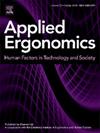The impact of snap-to-target on speed and accuracy in a Go/No-Go target detection task
IF 3.1
2区 工程技术
Q2 ENGINEERING, INDUSTRIAL
引用次数: 0
Abstract
Objective
– Determine the effect of snap-to-target functionality on speed and accuracy during a timed Go/No-Go task.
Background
– Baseline speed and accuracy data from Mensen et al. (2024), which required a motor task, were compared to data that implemented a snap-to-target modification to determine if replacing the motor task with automation would affect speed and accuracy performance.
Method
– Participants performed an online Go/No-Go agricultural based detection task, where they selected Go stimuli presented as images of weeds but were required to withhold on No-Go stimuli presented as images of soybean plants.
Results
– The present study which removed the motor task utilized in Mensen et al. (2024) demonstrated a decreased response time for stimuli that previously required a motor task, but there was a clear speed accuracy trade-off. The previously observed accuracy benefits observed in Mensen et al. (2024) when a motor task was required were not present in the current study.
Conclusion
– Implementation of snap-to-target capabilities, while decreasing response time, presents serious issues if implemented for tasks where high levels of accuracy are desired or required. The results of the study show that designers should be cautious of the accuracy implications particularly for the ability to withhold to infrequent or unexpected stimuli when implementing a snap-to-target system.
Application
Confirms a serious human factors liability of automated target detection and snap-to-target systems.
在Go/No-Go目标检测任务中,快照到目标对速度和精度的影响
目标-确定在一个定时Go/No-Go任务中,快照到目标功能对速度和准确性的影响。背景- Mensen等人(2024)的基线速度和精度数据与实施快照到目标修改的数据进行了比较,以确定用自动化取代运动任务是否会影响速度和精度性能。方法-参与者完成了一个在线的“去/不去”农业检测任务,他们选择了以杂草图像呈现的“去”刺激,但被要求保留以大豆植物图像呈现的“不去”刺激。结果-本研究删除了Mensen等人(2024)所使用的运动任务,表明对以前需要运动任务的刺激的反应时间减少,但存在明显的速度准确性权衡。先前在Mensen等人(2024)中观察到的在需要运动任务时的准确性益处在本研究中没有出现。结论——快速到目标功能的实现虽然减少了响应时间,但如果在需要或需要高精确度的任务中实现,则会出现严重的问题。研究结果表明,设计人员应该谨慎的准确性影响,特别是在实施一个快速到目标系统时,对不频繁或意外的刺激的抑制能力。应用证实了自动目标检测和快照到目标系统的严重人为因素责任。
本文章由计算机程序翻译,如有差异,请以英文原文为准。
求助全文
约1分钟内获得全文
求助全文
来源期刊

Applied Ergonomics
工程技术-工程:工业
CiteScore
7.50
自引率
9.40%
发文量
248
审稿时长
53 days
期刊介绍:
Applied Ergonomics is aimed at ergonomists and all those interested in applying ergonomics/human factors in the design, planning and management of technical and social systems at work or leisure. Readership is truly international with subscribers in over 50 countries. Professionals for whom Applied Ergonomics is of interest include: ergonomists, designers, industrial engineers, health and safety specialists, systems engineers, design engineers, organizational psychologists, occupational health specialists and human-computer interaction specialists.
 求助内容:
求助内容: 应助结果提醒方式:
应助结果提醒方式:


